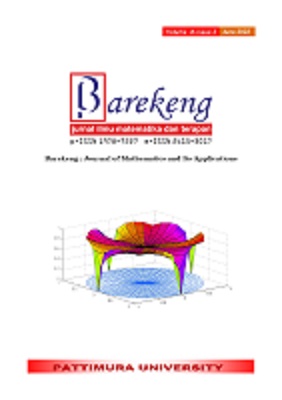THE OPTIMAL COMPOSITIONS OF DAILY MENU FOOD FOR BREASTFEEDING MOTHERS USING THE SIMPLEX METHOD
Abstract
In this research, we want to find the optimal compositions of the daily food menu for breastfeeding mothers at the minimum cost. These problems are formed into linear programs by including some available data, like the price of food in the traditional market, the nutritional content of each food, and the recommended nutritional adequacy rate. After that, we count the linear programs by using the Simplex method with the help of the LINDO solver. The output of this research is the weight of food consumed by mothers to meet their daily nutritional needs. Based on the data collected, we obtain the 36 food combinations that include the staple type of food (rice), the type of side dishes (pindang fish, tilapia fish, mackerel tuna, chicken eggs), the type of vegetables (cassava leaves, katuk leaves, moringa leaves), the type of fruits (melon, watermelon, orange), and the type of nut (peanuts). Next, we analyze the model according to the groups of breastfeeding mothers in the first and second 6 months. From this research, we obtain that the optimal compositions of the daily food menu for breastfeeding mothers in the first 6 months are cassava leaves. Meanwhile, the optimal compositions of the daily food menu in the second 6 months are rice and cassava leaves.
Downloads
References
Ministry of Health of the Republic of Indonesia, “Hasil Pemantauan Status Gizi Tahun 2016,” Ministry of Health of the Republic of Indonesia, 2017. https://kesmas.kemkes.go.id/assets/uploads/contents/others/Buku-Saku-Hasil-PSG-2016_842.pdf (diakses Jan 29, 2022).
Ministry of Health of the Republic of Indonesia, “Hasil Pemantauan Status Gizi Tahun 2017,” Ministry of Health of the Republic of Indonesia, 2018. https://kesmas.kemkes.go.id/assets/uploads/contents/others/Buku-Saku-Nasional-PSG-2017_975.pdf (diakses Jan 29, 2022).
A. Motee dan R. Jeewon, “Importance of exclusive breast feeding and complementary feeding among infants,” Curr. Res. Nutr. Food Sci., vol. 2, no. 2, hal. 56–72, 2014, doi: 10.12944/CRNFSJ.2.2.02.
T. A. E. Permatasari et al., “Exclusive breastfeeding intention among pregnant women,” Kesmas Natl. Public Heal. J., vol. 12, no. 3, hal. 134–141, 2018, doi: 10.21109/kesmas.v12i3.1446.
S. Ramadhani, J. I. Sari, dan R. Rahmadhani, “Study of Differences in Children Nutrition Status Aged 6-24 Months with Exclusive and Non-Exclusive Breastfeeding in Mattampa Bulu Village,” Green Med. J., vol. 3, no. 2, hal. 81–90, 2021, doi: 10.33096/gmj.v3i2.85.
S. Selvina, E. Fadlyana, dan N. Arisanti, “Relationship between Exclusive Breastfeeding and Nutritional Status of Infants Aged 12 months,” Althea Med. J., vol. 2, no. 4, hal. 534–540, 2015.
F. Ariseno, I. Cholissodin, dan E. Santoso, “Optimasi Kebutuhan Gizi Menggunakan Algoritme Evolution Strategies,” J. Pengemb. Teknol. Inf. dan Ilmu Komput., vol. 4, no. 7, hal. 2101–2110, 2020.
D. R. Pangestuti, “Nutritional status of exclusive compared to non exclusive breastfeeding mother,” J. Gizi dan Pangan, vol. 13, no. 1, hal. 11–16, 2018, doi: 10.25182/jgp.2018.13.1.11-16.
N. Kajale, A. Khadilkar, S. Chiponkar, J. Unni, dan N. Mansukhani, “Effect of traditional food supplements on nutritional status of lactating mothers and growth of their infants,” Nutrition, vol. 30, no. 11–12, hal. 1360–1365, 2014, doi: 10.1016/j.nut.2014.04.005.
Ministry of Health of the Republic of Indonesia, “Pedoman Gizi Seimbang,” Ministry of Health of the Republic of Indonesia, 2014. https://pergizi.org/pedoman-gizi-seimbang-2014-terbaru/ (diakses Jan 30, 2022).
Q. A. A. Ruhimat, R. J. Riftana, dan T. Dharmawan, “Implementation of simplex algorithm to optimize toddler’s balanced nutrition needs with minimum costs,” J. Phys. Conf. Ser., vol. 1539, no. 1, 2020, doi: 10.1088/1742-6596/1539/1/012038.
I. Kimutai, P. Maina, dan A. Makokha, “Energy Optimization Model Using Linear Programming for Process Industry: A Case Study of Textile Manufacturing Plant in Kenya,” Int. J. Energy Eng., vol. 9, no. 2, hal. 45–52, 2019, doi: 10.5923/j.ijee.20190902.03.
B. S. Anggoro, R. M. Rosida, A. M. Mentari, C. D. Novitasari, dan I. Yulista, “Profit Optimization Using Simplex Methods on Home Industry Bintang Bakery in Sukarame Bandar Lampung,” J. Phys. Conf. Ser., vol. 1155, no. 1, hal. 8, 2019, doi: 10.1088/1742-6596/1155/1/012010.
Nihaya Alivia Coraima Dewi, F. Resmi, dan P. T. B. Ngastiti, “Optimization of Balanced Menu for Pregnant Women in Grobogan-Central Java using Simplex Method,” J. Mat. MANTIK, vol. 7, no. 1, hal. 59–66, 2021, doi: 10.15642/mantik.2021.7.1.59-66.
Ministry of Health of the Republic of Indonesia, “Tabel Komposisi Pangan Indoensia 2017,” Ministry of Health, 2018. https://ahligizi.id/blog/2019/05/01/tabel-komposisi-pangan-indonesia-tkpi-terbaru/ (diakses Jan 27, 2022).
Ministry of Health of the Republic of Indonesia, “Peraturan Menteri Kesehatan tentang Angka Kecukupan Gizi yang Dianjurkan untuk Masyarakat Indonesia,” The Audit Board of the Republic of Indonesia, 2019. https://peraturan.bpk.go.id/Home/Details/138621/permenkes-no-28-tahun-2019 (diakses Jan 27, 2022).
Authors who publish with this Journal agree to the following terms:
- Author retain copyright and grant the journal right of first publication with the work simultaneously licensed under a creative commons attribution license that allow others to share the work within an acknowledgement of the work’s authorship and initial publication of this journal.
- Authors are able to enter into separate, additional contractual arrangement for the non-exclusive distribution of the journal’s published version of the work (e.g. acknowledgement of its initial publication in this journal).
- Authors are permitted and encouraged to post their work online (e.g. in institutional repositories or on their websites) prior to and during the submission process, as it can lead to productive exchanges, as well as earlier and greater citation of published works.






1.gif)



